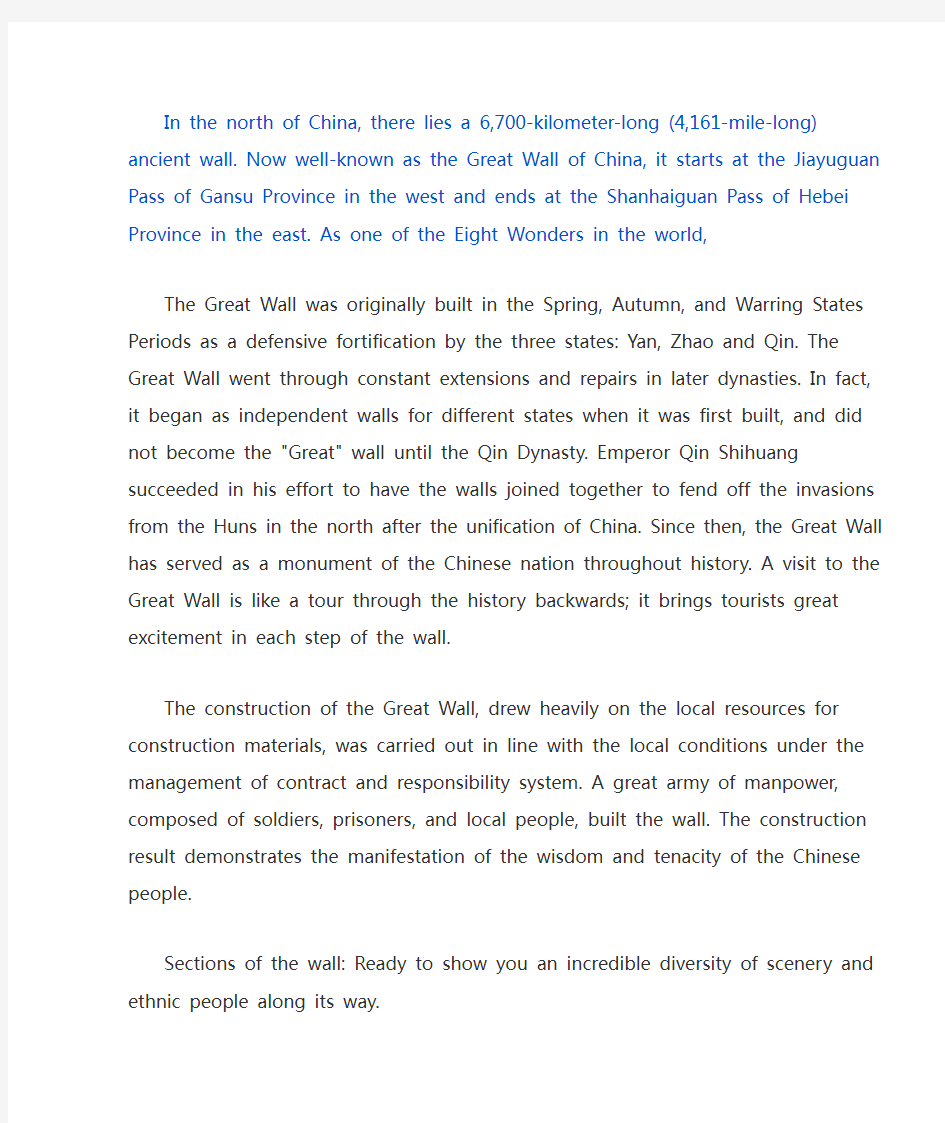用英语介绍长城


In the north of China, there lies a 6,700-kilometer-long (4,161-mile-long) ancient wall. Now
well-known as the Great Wall of China, it starts at the Jiayuguan Pass of Gansu Province in the west and ends at the Shanhaiguan Pass of Hebei Province in the east. As one of the Eight Wonders in the world,
The Great Wall was originally built in the Spring, Autumn, and Warring States Periods as a defensive fortification by the three states: Yan, Zhao and Qin. The Great Wall went through constant extensions and repairs in later dynasties. In fact, it began as independent walls for different states when it was first built, and did not become the "Great" wall until the Qin Dynasty. Emperor Qin Shihuang succeeded in his effort to have the walls joined together to fend off the invasions from the Huns in the north after the unification of China. Since then, the Great Wall has served as a monument of the Chinese nation throughout history. A visit to the Great Wall is like a tour through the history backwards; it brings tourists great excitement in each step of the wall.
The construction of the Great Wall, drew heavily on the local resources for construction materials, was carried out in line with the local conditions under the management of contract and responsibility system. A great army of manpower, composed of soldiers, prisoners, and local people, built the wall. The construction result demonstrates the manifestation of the wisdom and tenacity of the Chinese people.
Sections of the wall: Ready to show you an incredible diversity of scenery and ethnic people along its way.
The Great Wall as we see today was mostly built during the Ming Dynasty. It starts from Shanhaiguan Pass in the east to Jiayuguan Pass in the west traversing provinces of Liaoning, Hebei, Beijing, Tianjin, Shanxi, Inner Mongolia, Ningxia, Shaanxi and Gansu.
Protection of the wall: The China Great Wall Academy has called for greater protection of this important relic.
Following a forty-five day long survey of 101 sections of the Wall in different provinces, the China Great Wall Academy reported on December 12, 2002 that the forces of nature and destruction at the hand of mankind are bringing about the gradual reduction of its extent with the result that less than 30% remains in good condition. The Academy has called for greater protection of this important relic.
Culture of the wall: Unfolding a considerable part of Chinese culture beyond the wall.
The Great Wall has long been incorporated into Chinese mythology and popular symbolism. The most beautiful of several legends is about the collapse
of a section of the Great Wall caused by Meng Jiangnu, who cried bitterly over the death of her husband in the construction of the Great Wall. This legend has been spread widely through textbooks, folk songs and traditional operas. It is well-known in China.
Travel of the wall: Elaborate tour plans make travel comfortable, memorable, enjoyable and informative.
